In the warmth of a bonfire, women of Bagra village in Arunachal Pradesh break into a melodious folk song celebrating the relationship between farmers and insects that grow alongside paddy. Listening to them intently are young scientists from Rajiv Gandhi University, keen to someday take the traditional practice of eating insects out of the inaccessible villages of Arunachal to the premium restaurants of the world.
Back in their lab they arranged several species of edible insects onto a plate for a picture, they put a spoon too. “This is our vision, one day this will happen,” says Pompi Bhadra, a PhD candidate at RGU, studying ‘entomophagy in the northeast’.
She is among six PhD candidates at RGU documenting edible insects – from stinkbug that seems to cause hallucinations in some people to pests that pose threat to the state’s kiwi plantations.
Building on the age-old tribal practice of eating insects that for centuries have been part of the regular diet of farming communities in Arunachal Pradesh, the young scientists are trying to learn more about abundance of the insects, their nutritional profile and medicinal properties. In the context of the ongoing climate crisis and the global threat to food security, the group is exploring the possibility of getting past stereotypes to bring alternate sources of nutrition to the table.
And at the helm of their mission is a woman who has been climbing mountains – literally and figuratively. Jharna Chakroavorty has been working to understand the ancient eating practices of Arunachal and pitching them as solutions that can address the global food security problem. Traversing the vast stretches of tribal lands, and fighting systemic challenges of conducting science in the Northeast, Chakroavorty races against time, as she nears her retirement, to unlock some of the mysteries of the hundreds of species of insects part of the Arunachal’s tribal palettes.
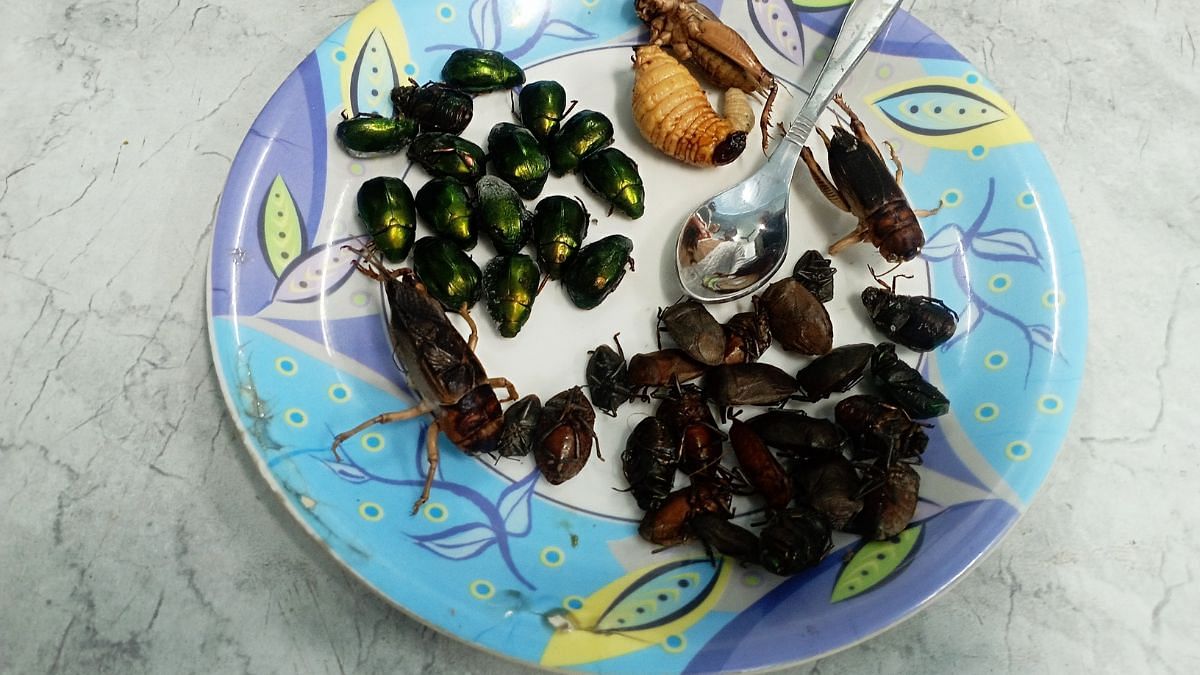
Diminishing forests, increased availability of other food sources, and influence of ‘modern’ lifestyle is affecting the diversity, abundance and use of edible insects, leading to a decline of entomophagy among the tribal people.
“We are not taking entomophagy (insect eating) seriously because we have not yet reached that immense food security crisis, but the world is already recognising that insects are the sustainable food source of the future” says Chakroavorty.
Insects are either deep fried – to be eaten as a snack accompanying local wines – or cooked into a spicy chutney. Some are kinds of bugs cooked with bamboo shoots, as an accompanying dish. A concoction of ground-up black ants or Bothroponera rufipes, mixed in water can even relieve toothache. The ants are also believed to manage high blood pressure.
Back in the lab
In Chakroavorty’s lab, a fridge is filled with thousands of creepy crawlies. For a regular visitor, it would be the stuff of nightmares. But she and her PhD candidates represent a shared dream – to put these insects on the world’s finest gourmet menus.
“We hope that one day this tradition will become a trend,” says Pompi Bhadra, who is assessing the gut microbes of these insects and also studying the antibacterial and antioxidant potential of edible insects.
The West is already doing it, Bhadra points out. There are companies making cookies from grasshoppers.
Last year, in April, Singapore approved 16 species of insects for human consumption.
“It’s unfortunate, unless the West does something, we Indians do not try it,” says Chakroavorty.
The professor learnt this the hard way.
Nearly two decades ago, the practice piqued her interest when she noticed that students at the university would linger around in the evening underneath street lamps and look for something amid the stones. Curiosity got the better of her. And upon enquiring, she began to learn about the insects that those students consumed.
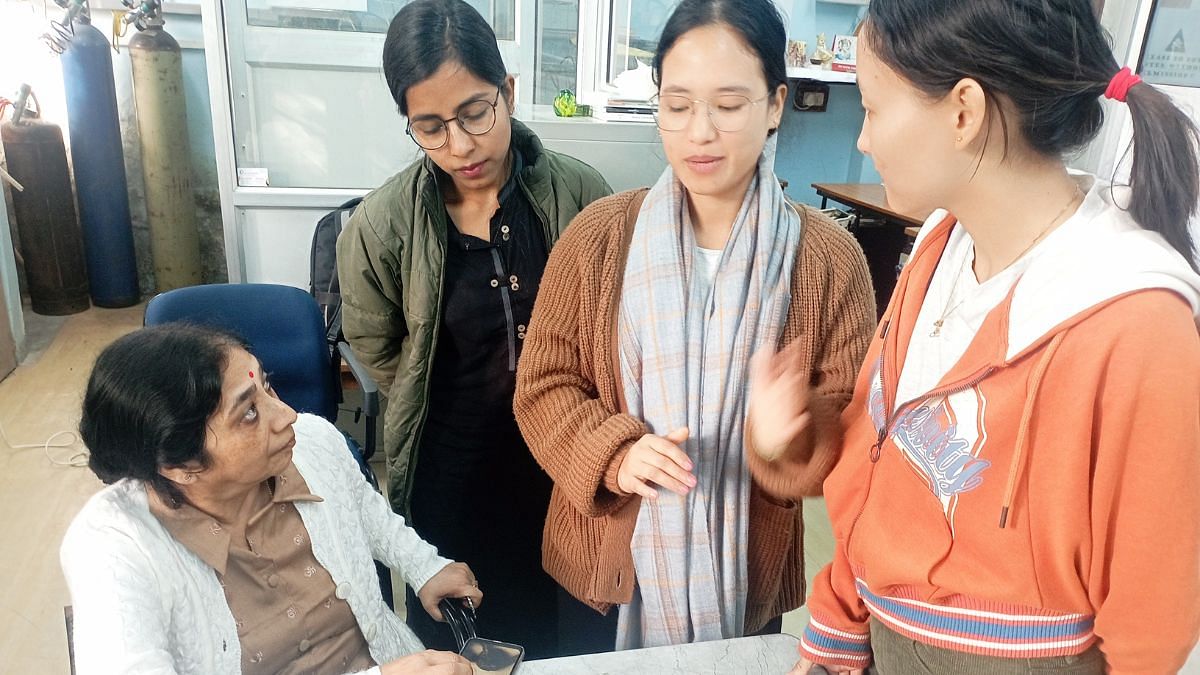
The first time Chakroavorty applied to the Department of Science and Technology (DST) for funds for studying entomophagy in Arunachal Pradesh was in 2001 – but her proposal was rejected.
“Nobody in India wanted to study this, nor did they see any future in this line of research.” Even within Arunachal, the younger generation shied away from promoting entomophagy, fearing being judged in the modern world.
Not backing down, she applied for a research grant with the International Foundation for Science, which was immediately granted.
Over the years, Chakroavorty has managed to accrue research grants from the DBT, which eventually helped her buy state-of-the-art equipment in her own lab at RGU.
But science in Arunachal Pradesh has many metaphorical mountains to cross. Chakroavorty quickly realised that the unreliable power supply in the state made it impossible for her to run experiments in her laboratory and the university too does not have 24X7 power back up.
“If the instruments stop working in the middle of a running experiment, the entire sample becomes useless.”
Once, a power surge caused one of her instruments to catch fire. “It was right next to the hydrogen cylinders in the lab. My students had a quick presence of mind and put out the fire – we averted a major disaster.”
The team now sends its samples to various labs as far as Delhi, Bangalore, Hyderabad and Bombay for nutritional analysis. Even for that, Chakroavorty has to source dry ice for her samples all the way from Assam, as it is not available in Arunachal.
For analysing the bugs for the nutrition they provide, Minam, Chakroavorty’s PhD student, needs to prepare a sample of fifty grams of dried and powdered bug.
“That is going to be hundreds of bugs. Even if I sat turning rocks for days, I am not going to be able to find so many. And then, the villagers are not going to let me collect and take that much in one go,” Minam says.
Despite the challenges, between the Galo and Nyishi tribes of Arunachal Pradesh, Chakroavorty has identified at least 81 species of insects that are consumed by the tribes.
The traditional custodians of the Adi land — area inhabited by the Adi tribe — are not so willing to let anyone collect insects from their area.
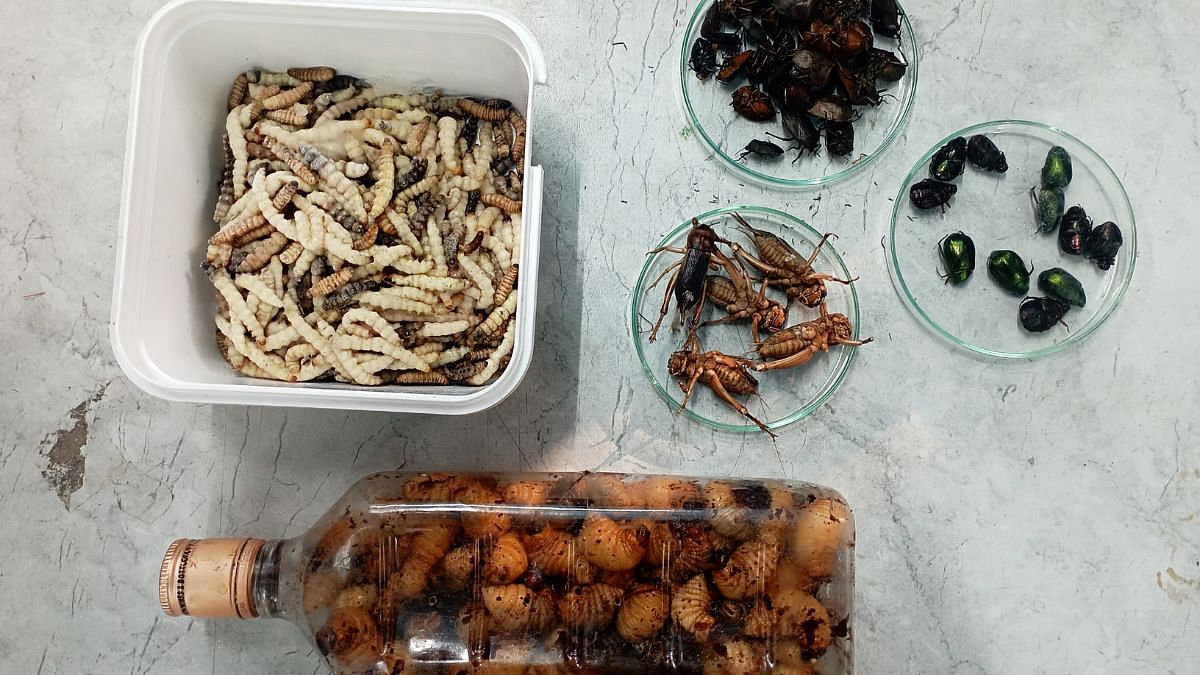
Kayon Perme, aged 28, is among the people of the Aying village who are keeping a strict eye on the road leading up to the river bank. The community is wary of tourists who come to the picturesque river bank and litter it with trash.
They are also protecting their stinkbug, also known as gaundipuk, or tari from being over exploited by other villagers – since they believe that theirs do not get people sick as often.
“Others come and take so much of it that there would be nothing left for the villagers’ consumption,” Koyong said.
Though this is welcome step towards conserving the resources, it makes Minam’s work all the more difficult.
The vast distances that the research group has to cover to collect their samples is another challenge. According to the scientists, a driver usually charges Rs 5,000 for a day’s trip – but the university only sanctions Rs 3,000. With a mere Rs 8,000 as their stipend, conducting research is cost prohibitive.
Projects grants that Chakroavorty has been applying for has kept the lab running for the last two decades.
“I have not been getting many promotions because I cannot publish papers as fast as researchers from other states. The UGC should understand that there is a huge difference between a paper published from Bengaluru and a paper published from Arunachal Pradesh,” Chakroavorty laments.
Even to get her species identified, Chakroavorty has to make trips to the Zoological Survey of India (ZSI) Kolkata. A particular species they sent has been sitting unidentified with the ZSI for over two years.
Even so, Chakroavorty collaborating with researchers from as far as Germany and Sweden has documented over 100 edible insects from Arunachal.
She is still battling the aversion might be better that plagues the minds of those who are not used to the idea of eating insects.
“I still get asked at every conference if I have tasted them myself,” she said.
“The new generation is not interested in these things, and we risk losing valuable traditional knowledge about edible species,” Chakroavorty told ThePrint.
During her field trips, Minam, Bompu and Nending try to engage more with the village elders to learn from them more about their own culture – and possibly identify species of bugs that are common knowledge among the tribes – that’s unknown to science.
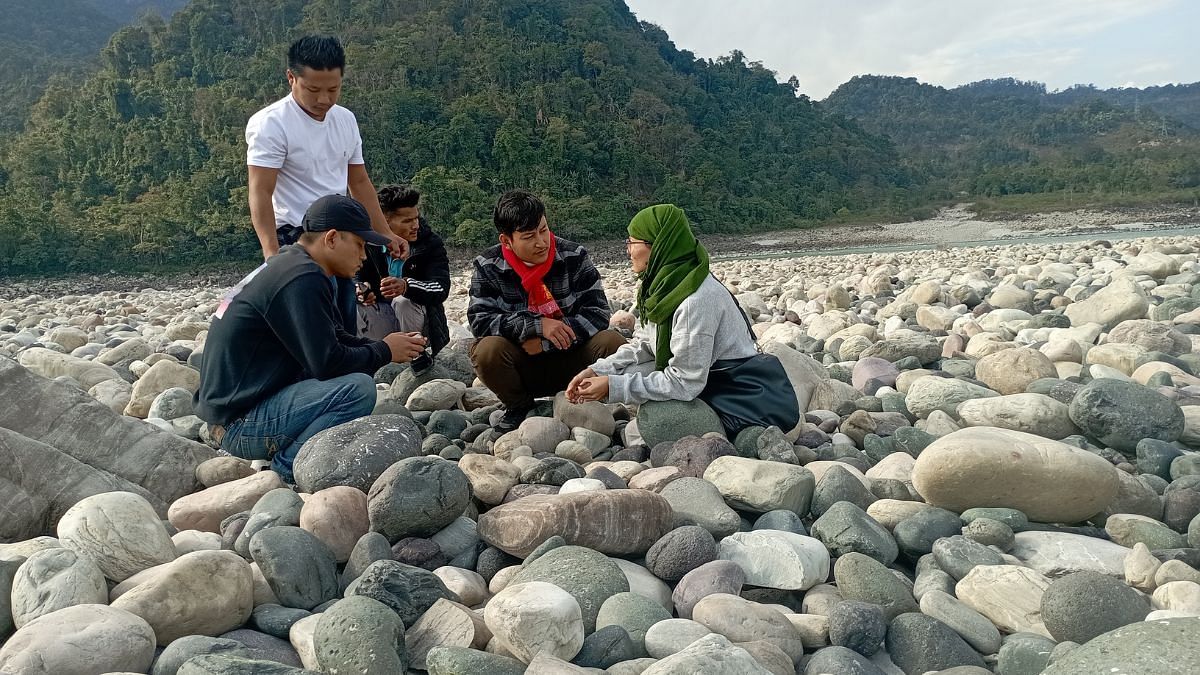
Gaundipuk and the Adi tribe
On the banks of river Siang, a surefooted Minam picks her way across the multi-hued rocks that have been smoothened to perfection by the water over centuries. She begins to turn them over one by one, searching for a six-legged creature that crawls among these rocks. Within minutes, she finds one, and calls over her lab mates to take a look.
Dissecting the insect on the spot, she explains to them its anatomy.
“Can you smell it?” she asks her colleagues.
A pungent smell is the defining trait of a stinkbug. The bug is a coveted delicacy for the Adi tribe in the state. Minam has been collecting these insects from the Siang riverbed since her childhood, alongside other members of her tribe.
In winters, the number of these insects swell and members of the Adi tribe come looking for them. They have two reasons – The bug’s smell attracts rats, which is what the tribe hunts to eat; and a chutney cooked with hot spices and ginger.
The bug though has a strange side effect that is yet to be explained — hallucinations.
Beltom Perme, a 59-year-old resident of Aying village in Pasighat.
“When it (hallucinations) happened – I started trying to behave like the insect. I was trying to fly and wanted to hide in some dark place,” says Beltom Perme, a 59-year-old resident of Aying village in Pasighat, laughing. He had fever for a couple of days, and experienced nausea.
Far away in Menchukha – one of the last towns of India on the northeastern border – one can find tari among the stones in the river bed. Yapung Yarung, a school teacher, told ThePrint that in this small town too, the insect is considered a delicacy.
“Once my cousin fell sick too. People start acting like the bug, they flinch from bright light – and try to crawl under the table or sofa. One of my cousin’s hallucinations lasted a week. But when sister was affected she threw up – so her spell of sickness lasted just a couple of days,” says Yarung.
And there is no medicine, modern or traditional, that can help treat those who are affected.
“Doctors get irritated when they get patients who got sick because of tari. You will get no cure from them, only curses,” she says.
Usually, local dispensaries keep such patients under observation, give them a saline drip and cover them with a blanket till their hallucinations pass.
Yapung said that her tribe believes such sickness happens if one eats the bug that had not been caught alive.
“I do not know if there is any science behind this,” she says.
But it is not as if the bug affects everyone. “It might be that out of ten people eating the same batch of chutney, one might fall ill. Maybe it has to do with immunity,” says Yapung.
Chakroavorty wants to investigate and go beyond the guess work. And she is joined by her PhD students.
They have much to decode about the stinkbug – first of which is to identify whether it is a distinct species. For over two years now, ZSI Kolkata has been unable to tell Chakroavorty if she has found new species of bugs.
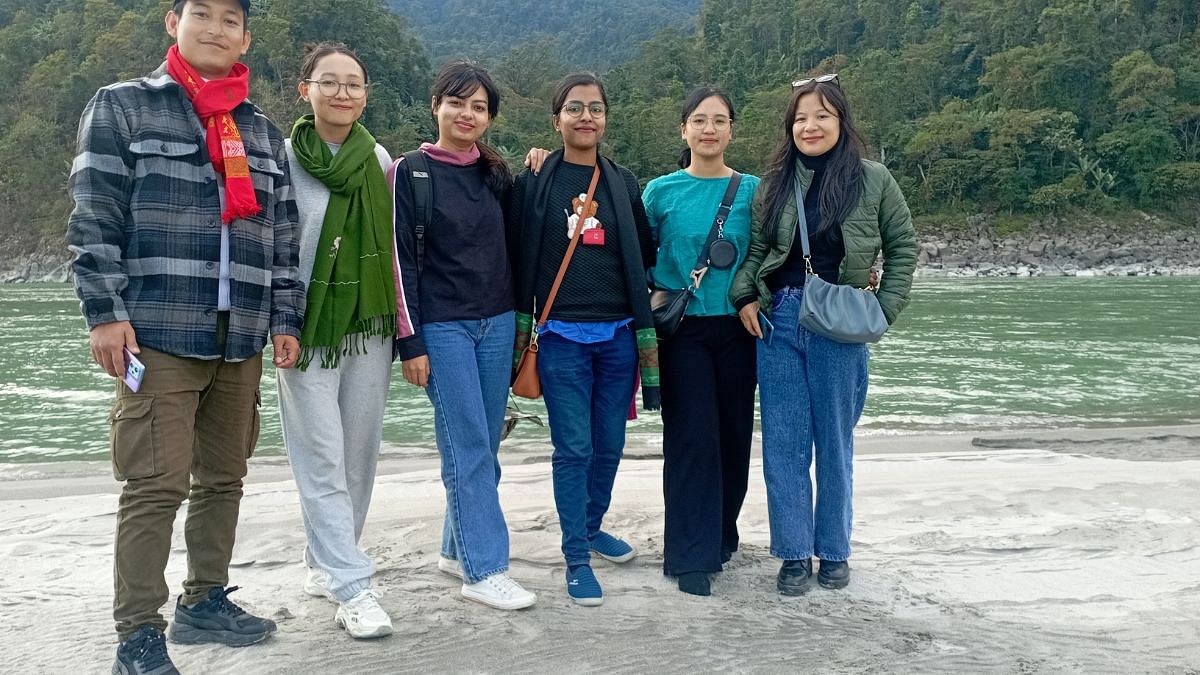
Until they do so, Chakroavorty cannot proceed with any publications. With just three years left until her retirement, she feels like she is in a desperate race against time.
The RGU professor has isolated the components of the tari that local tribes say cause hallucinations – and is now in talks with National Centre for Biological Sciences (NCBS) Bangalore to identify the halucinogenic component.
She also wants to carry out genetic sequencing among the tribes to find out if a particular gene mutation makes certain people more prone to hallucinogens.
Chakroavorty has documented at least 53 edible insect species, including crickets, caterpillars and termites that are consumed by the Adi tribe.
Galo tribes
About half-an-hour from the town of Aalo in the West Siang district village Bagra is home to Arunachal’s Galo tribe and another one of Chakroavorty’s PhD student, Bompu Bagra. The fields flanking the roads of the village are lined with ripe oranges. Small plots of land on the slopes of mountains are lined with neat rows of pineapples.
Wading through ankle-deep waters of a freezing cold natural stream just about 10 minutes from her home, Bompu sieves through the waters with a raju – a conical basket made of cane.
For several minutes, Bompu patiently sifts through pebbles and dry leaves that get caught in her raju. Suddenly, she exclaims in delight — and her colleagues open-up little plastic box, ready to trap the dolatak — one of the many freshwater edible insects consumed by her Galo tribe.
“It’s simply about conserving time and resources. When we come fishing for shrimps and small river water fishes and crabs, all the insects that get caught is also cooked and consumed. We do not pick them out,” Bompu says.
Across the river, a half-an-hour trek leads up to her family’s step-cut paddy fields.
“We do not have vast stretches of land to grow cattle, and farming takes a lot more time and effort. Insects on the other hand are an excellent source of protein – and can be caught while farming,” she adds.
Even as she talks about her farm and culture – Bompu suddenly lunges forward in the grass to grasp at something.
She opens her fist to reveal a small, black critter – yaaru. Various kinds of cricket form an integral part of the Bagra’s folklore. The Galo tribes believe that the life of the cricket is intricately linked to the health and the growth of paddy.
“So when the paddy crop is ready to be harvested, these insects are ready for consumption,” she says.
Back at her home that evening, her relatives gather around a fire. Just like Minam, Bompu also has instructions from Chakroavorty to learn more about her culture and forgotten edible insects from the elders in her family and the village.
Marka Bagra, Bompu’s elderly relative, tells her the local names of various insects that they traditionally eat. But there is tough work ahead for Bompu and her lab mates.
She will have to get the knowledgeable village elders to identify the insects associated with this list of local names – and then go about identifying the genus and species.
Across tribes, there are differences in beliefs, for example, Chakroavorty found that some insects consumed by the Nyishi tribes are not consumed by the Galos – as the latter believe these could be toxic.
Apatani tribes
The Ziro village in Arunachal is well known to tourists for its annual music festival that is attended by fans from all over the world.
Having the advantage of relatively flatter terrains, the valley boasts of vast strengths of bamboo and pine plantations. But more recently, Ziro has seen an expansion in kiwi plantations – a crop that was not quite as popular in the state until the turn of this millennium.
While the popularity of the fruit turned around the fortunes of many farmers – it also brought a bounty of edible insects for plantation workers.
Jojer, as members of the Apatani tribes call it, are usually found in forests. According to Taku Doilyang, a 37-year-old employee at a kiwi plantation, it has only been a few years since they noticed that they can find jojer in the leaves of the kiwi crop.
“I found it one day while farming. We realised it is one of the three varieties of jojer that our families used to find. But earlier, this was a rare find in forests,” Doilyang told ThePrint.
Instead, another variety of the insect would be found in bamboo forests around the month of June.
“We would spread tarpaulin sheets on the forest floor, and then shake the tall plants and collect the jojer from the floor,” he recalls.
But now, the widespread kiwi plantations have provided the perfect nesting spots for the insects.
Nending Muni, another PhD student in Chakroavorty’s lab is a native of Ziro – and a proud member of the Apatani tribe.
In a paper published in the journal Current Science in June last year, Muni and Chakroavorty documented this incredible success story of sustainable practices in the horticulture cash crop.
Muni found that jojer, an adult member of the Anomala species, was a pest for the kiwi crop. The crops should have been damaged by these pests had it not been for the workers collecting and consuming the pests.
“…one cannot expect absolute control over huge swarming pests by merely collecting and consuming them. Yet, in the Ziro valley, the entomophagy practice of these beetle pests by the Apatanese can be viewed as an exemplary example of sustainable management with local traditional, socio-cultural practice in non-native cash crops while avoiding harmful insecticides or pesticides,” says Muni.
Muni is set to complete her PhD this year – and is especially interested in studying more of the edible insects that are pests.
Like her peers, she is keen on preserving her culture and ethnic knowledge.
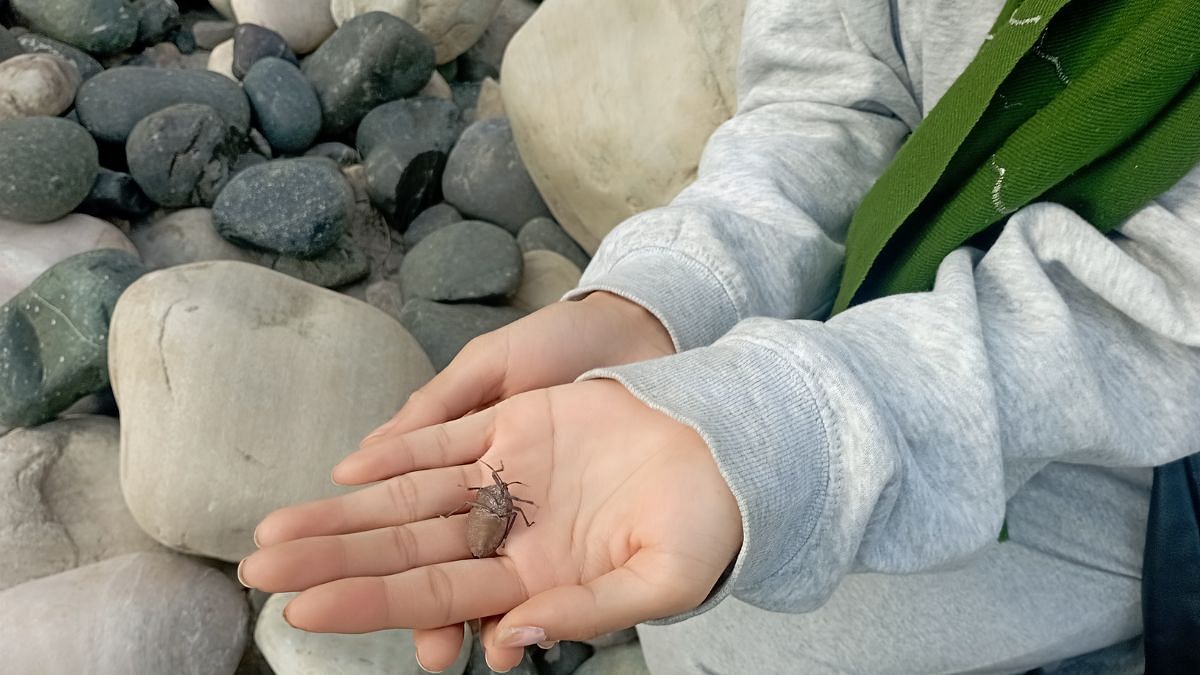
In the land but not on market
Sitting with Minam in Aying, Beltom talks about how to handle the stinkbug Tari.
“Don’t let its juice touch your eyes, you’ll go blind. And when you cut it, remove that red gland carefully with a stick. Otherwise, you’ll stain your fingers.”
Minam laughs and shows Beltom her stained fingertips – a result of her riverside dissection earlier. The prepared chutney can be consumed for up to a week if kept wrapped in Ekum leaves, he tells Minam, before hurrying off to hunt rats.
For generations, the recipes to cook these insects have been handed down.
“The red gland is very spicy! If you eat that directly you’ll burn your tongue. You can cook it with red chillies and ginger. Or boil it – it will be very tasty!” Beltom tells Minam.
According to Beltom, these insects larvae grow in the forests – but in the winters they mature and fly up to 5 km to find refuge under the rocks on the riverbed. Between December and March, it is the peak season for the tari.
In the larval form, the insect is found hanging on vines in the forests – and some varieties of these can be eaten too, Beltom tells Minam.
“If people have been eating this for so long, it must have some nutritional value,” Minam tells ThePrint.
Despite entomophagy being common practice, none of these insects are sold in local markets.
“If we are able to start culturing some of these edible species in the laboratory, there can be a huge potential for ushering in a new range of products in nutraceuticals and pharmaceuticals space,” says Muni.
In the context of climate change and shrinking availability of land and water resources, it is much more viable to open farms that culture insects than expand cattle or poultry farming, Bompu says.
“There was a time when the West looked down on seafood. And now lobsters, shrimps and crabs are the most expensive items on the menu,” says Muni.
But according to her, the biggest market potential is the South East Asian countries – where the food culture is very similar to those of the North East.
Muni is set to complete her PhD later this year. Asked if she is considering a startup, she seems unsure.
The bunch of young researchers led by a professor whose career is sunsetting is of the opinion that the time is not yet ripe for India to start an F&B business based on insects. For now, there is a lot of work left to be done – identifying the right species, learning to grow them in lab settings, and isolating the right nutritious components.
The journey to develop products like cookies and protein bars can only start then.
“We are more than ten years behind the world on this, even though our civilisation has been practising entomophagy for the longest time,” says Chakroavorty.
“Arunachal Pradesh is an integral part of India – so yes, insects are already very much a part of the Indian cuisine,” Muni said.
(Edited by Anurag Chaubey)
News Related-
Anurag Kashyap unveils teaser of ‘Kastoori’
-
Shehar Lakhot: Meet The Intriguing Characters Of The Upcoming Noir Crime Drama
-
Watch: 'My name is VVS Laxman...': When Ishan Kishan gave wrong answers to right questions
-
Tennis-Sabalenka, Rybakina to open new season in Brisbane
-
Sikandar Raza Makes History For Zimbabwe With Hattrick A Day After Punjab Kings Retain Him- WATCH
-
Delayed Barapullah work yet to begin despite land transfer
-
Army called in to help in tunnel rescue operation
-
FIR against Redbird aviation school for non-cooperation, obstructing DGCA officials in probe
-
IPL 2024 Auction: Why Gujarat Titans allowed Hardik Pandya to join Mumbai Indians? GT explain
-
From puff sleeves to sustainable designs: Top 5 bridal fashion trends redefining elegance and style for brides-to-be
-
The Judge behind China's financial reckoning
-
Arshdeep Singh & Axar Patel Out, Avesh Khan & Washington Sundar IN? India's Likely Playing XI For 3rd T20I
-
Horoscope Today, November 28, 2023: Check here Astrological prediction for all zodiac signs
-
'Gurdwaras are...': US Sikh body on Indian envoy's heckling by Khalistani backers
